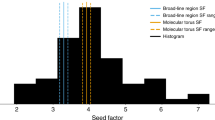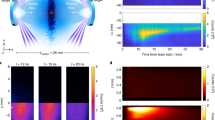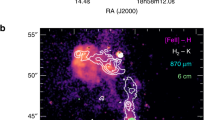Abstract
Observations show that jets in moderate luminosity (<1025 W Hz−1 at 20 cm wavelength) radio galaxies can flare dramatically in a few jet diameters and with opening angles up to 90° into diffuse lobes or tails1–4 (Fig. 1). These morphologies are difficult to reproduce in numerical simulations of supersonic jets that move outward in constant5,6 or smoothly varying atmospheres (N. Norman, unpublished results). By analogy with structures seen in the laboratory7, one could interpret the collimated jets as moderately supersonic (Mach number 2–5) fluid flows, and the lobes or tails as subsonic plumes that are subject to turbulent broadening and entrainment of the ambient medium. Our studies indicate that the transition from supersonic to subsonic flow can occur suddenly only if a strong planar (normal to the flow direction) shock or Mach disk forms within the jet. Here we show that such an internal shock is produced as the jet crosses a shock wave in the external medium. The external shock could form, for example, by a galactic wind encountering the intergalactic medium. We find that for jet disruption the jet Mach number must be less than the wind-shock Mach number, a result also understandable from analytic arguments. We apply this model to Cen A and wide-angle-tailed radio galaxies.
This is a preview of subscription content, access via your institution
Access options
Subscribe to this journal
Receive 51 print issues and online access
$199.00 per year
only $3.90 per issue
Buy this article
- Purchase on Springer Link
- Instant access to full article PDF
Prices may be subject to local taxes which are calculated during checkout
Similar content being viewed by others
References
Burns, J. O., Fiegelson, E. D. & Schreier, E. J. Astrophys. J. 273, 128–153 (1983).
Perley, R. A., Willis, A. G. & Scott, J. Nature 281, 437–442 (1979).
Eilek, J. A., Burns, J. O., O'Dea, C. P. & Owen, F. N. Astrophys. J. 278, 37–50 (1984).
O'Donoghue, A. & Owen, F. N. in Radio Continuum Processes in Clusters of Galaxies (eds O'Dea, C. D. & Uson, J. M.) 155–160 (National Radio Astronomy Observatory, Green Bank, 1986).
Norman, M. L., Smarr, L. L., Winkler, K.-H. A. & Smith, M. D. Astr. Astrophys. 113, 285–302 (1982).
Norman, M. L., Winkler, K.-H. A. & Smarr, L. L. Physics of Energy Transport in Extragalactic Radio Sources, (eds Bridle, A. H. & Eilek, J. A.) 150–167 (National Radio Astronomy Observatory, Green Bank, 1984)
Shirie, J. W. & Seubold, J. G. Am. Inst. Aeronaut. Astronaut. J. 5(11), 2062–2064 (1967).
Bridle, A. H. & Perley, R. A. A. Rev. Astr. Astrophys. 22, 319–358 (1984).
Landau, L. D. & Lifshitz, E. M. Fluid Mechanics 336 (Pergamon, New York, 1982).
Burns, J. O. Can J. Phys. 64, 373–378 (1986).
Feigelson, E. D. et al. Astrophys. J. 251, 31–51 (1981).
Loewenstein, N. & Mathews, W. G. Astrophys. J. 319, 614–631 (1987).
Mathews, W. G. & Baker, J. Astrophys. J. 170, 241–259 (1971).
Stocke, J. T. & Burns, J. O. Astrophys. J. 319, 671–682 (1987).
Williams, R. E. & Christiansen, W. A. Astrophys. J. 291, 80–87 (1985).
Gopal-Krishna & Saripalli, L. Astr. Astrophys. 141, 61–66 (1984).
Malin, D. F., Quinn, P. J. & Graham, J. A. Astrophys. J. 272, L5–L7 (1983).
Quinn, P. J. Astrophys. J. 279, 596–609 (1984).
Fanaroff, B. L. & Riley, J. M. Mon. Not. R. astr. Soc. 167, 31–41 (1974).
Norman, M. L. & Winkler, K.-H. A. (eds) Astrophysical Radiation Hydrodynamics, 187–221 (Reidel, Dordrecht, 1986).
Clarke, D. A. thesis, Univ. New Mexico (1988).
Author information
Authors and Affiliations
Rights and permissions
About this article
Cite this article
Norman, M., Burns, J. & Sulkanen, M. Disruption of galactic radio jets by shocks in the ambient medium. Nature 335, 146–149 (1988). https://doi.org/10.1038/335146a0
Received:
Accepted:
Issue Date:
DOI: https://doi.org/10.1038/335146a0
Comments
By submitting a comment you agree to abide by our Terms and Community Guidelines. If you find something abusive or that does not comply with our terms or guidelines please flag it as inappropriate.



